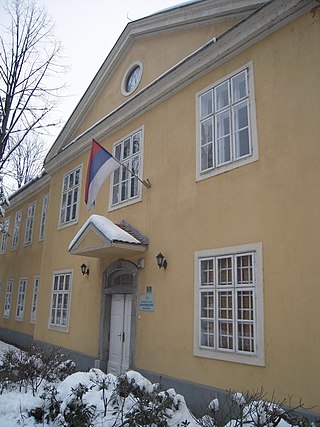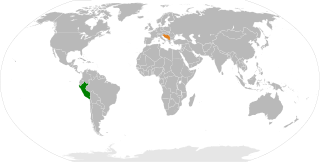Foreign relations of Serbia are accomplished by efforts of the Ministry of Foreign Affairs. Serbia has inherited the Ministry of Foreign Affairs, along with all of its holdings, after the dissolution of the previous state union with Montenegro. Serbian foreign ministries continue to serve citizens of Montenegro in countries that do not have Montenegrin diplomatic presence. The governments of Serbia and Montenegro expressed an interest in pursuing a common foreign policy. Former President of Serbia Boris Tadić referred to relations with the European Union (EU), Russia, United States and China as the four pillars of foreign policy. Serbia joined the United Nations on 1 November 2000.

The Ministry of Foreign Affairs of the Republic of Serbia is the ministry in the government of Serbia which is in the charge of maintaining the consular affairs and foreign relations of Serbia. The current minister is Marko Đurić, in office since 26 October 2022.

Peru–Serbia relations are foreign relations between Peru and Serbia. Both countries are members of the United Nations.

Serbia–Venezuela relations are foreign relations between Serbia and Venezuela. Venezuela is represented in Serbia through its embassy in Belgrade. Serbia is represented in Venezuela through its embassy in Caracas that was re-opened in 2023.

The Archive of Serbia, is the national archive of Serbia, located in Belgrade. It houses and protects documents and other archival materials produced by state bodies and organizations of Serbia before 1918 and documents produced during and after World War II. Documents dating from the period when Serbia was part of the Kingdom of Yugoslavia and documents produced by the state bodies and organizations of Yugoslavia from 1918 to 2006 are kept in the Archives of Yugoslavia, also in Belgrade.
Visitors to Serbia must obtain a visa from one of the Serbian diplomatic missions unless they are citizens of one of the visa-exempt countries.
State decorations of the Republic of Serbia are regulated by the 2009 Law on Decorations.

Vladislav Jovanović is a Serbian diplomat who was Minister of Foreign Affairs of Serbia and Montenegro.

Marko Đurić is a Serbian politician and diplomat serving as the minister of foreign affairs since 2024. Prior to becoming a government minister, Đurić was the ambassador of Serbia to the United States of America since 8 October 2020, and the non-resident ambassador of Serbia to Colombia since 3 July 2021.

The Archives of Republika Srpska is an administrative organisation within the Ministry of Education and Culture of Republika Srpska, one of two constituent entities of Bosnia and Herzegovina. The Archives' headquarters is in Banja Luka, and it has its regional offices in Doboj, Zvornik, Foča, Sokolac, and Trebinje. Its aim is to collect, store, preserve, organise, research, and provide access to archival materials on the territory of Republika Srpska, where it is designated as a central institution for the protection of cultural heritage. The Archives is also involved in research projects, exhibitions, and in the publishing of books and scholarly papers, mostly in the fields of archival science, history, and law. It is organised into two sectors, which are responsible for the protection of archival materials within and outside the Archives, respectively. The Archives currently holds 794 fonds and 35 collections, which span the period from the 17th century to the modern day.

The Ministry of Foreign Affairs Building is the headquarters of the Ministry of Foreign Affairs of Serbia. It is located in Savski Venac, Belgrade, with the Government Building across Nemanjina Street.

The Government Building, formally the Government of the Republic of Serbia Building is the seat of the Government of Serbia. It houses the office of the Prime Minister as well as the Secretariat-General of the Government, and serves as a meeting place of cabinet of ministers. It is located in Savski Venac, Belgrade.

Peru–Yugoslavia relations were historical foreign relations between Peru and Yugoslavia. Both countries had amicable relations and were active in the Non-Aligned Movement which was established in Belgrade in 1961. Peru had an embassy in Belgrade until 2006 and Yugoslavia, later Serbia, had an embassy in Lima until 2009.
Branko Mikašinović, was a Yugoslav and Serbian diplomat and politician who held the office of Serbian Minister of Foreign Affairs in the 90s.

Konstantin A. Fotić was a Serbian lawyer and diplomat.

The Embassy of the Republic of Serbia in Peru was the diplomatic mission of the Republic of Serbia to the Republic of Peru. From its establishment in 1968 until 2006, the embassy represented the Socialist Federal Republic of Yugoslavia and its successor, the Federal Republic of Yugoslavia. Its closure was announced in May 2009.
The Military Archive of the Ministry of Defence of the Republic of Serbia is the primary military history archive located in Belgrade, Serbia. The institution was originally established by a decree from Prince Milan Obrenović on February 5, 1876, based on proposal of Jovan Dragašević in 1865. The Military Archive has preserved records of significant events, including the Serbian-Ottoman wars, Balkan Wars, the First World War, and World War II with approximately 40 million archival records in institutional holdings. The Military Archive is not legally allowed to directly communicate with foreign citizens or organizations. Instead, researchers with foreign citizenship who wish to access its materials must submit their applications via the Serbian diplomatic representation abroad or through their respective embassy in Serbia.















